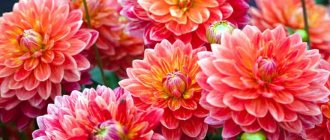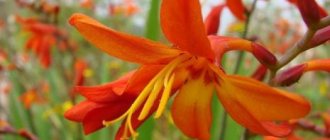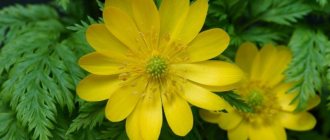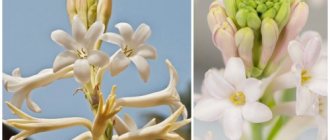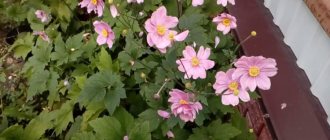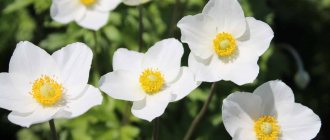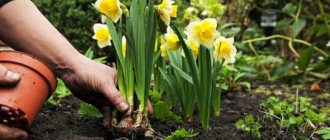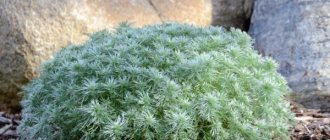Characteristics of perennial varieties
Perennial varieties of dahlias are in demand among gardeners because they have a number of advantages:
-Wide variety of species and varieties. So, currently there are approximately 15,000 varieties.
-Varieties differ from each other both in the color of the buds and in the shape of the flowers themselves. The petals can be forked, elongated or even curled.
-Dahlias bloom for a very long period - starting in June and ending in late autumn.
-Undemanding and unpretentious.
-If you follow simple growing rules, dahlias can grow in one place for several years.
Parts of a flower
The dahlia consists of several main parts. This is an inflorescence. Its size can be either 3 cm or 30 cm in diameter. The inflorescence consists of marginal petals, which have a very wide variety of colors and shades, and internal, usually yellow, petals.
The stem of the plant can reach a length of one and a half meters. Low-growing varieties do not exceed 20 cm in height. Despite the fact that the stem looks quite powerful on the outside, it is empty inside, so it is better to tie up too long plants.
Dahlia roots are large tubers or their second name is root cones.
The heart of the dahlia is represented by the root neck. It is here that the buds necessary for the growth and development of the plant are formed, and it is also the connecting link between the stem and root tubers. If the root collar is damaged, the plant will die.
Periods of plant development
As a rule, this crop is propagated by tubers. Those flowers that were grown from seeds or by cuttings form a fairly powerful new root within a year. It can be planted on the site for the next season.
Before the winter dormant period of dahlias, the tubers should be carefully dug out of the soil so as not to damage the root collar and stored in a cool, dark place. When spring comes, new shoots sprout from the vegetative buds of the root collar. And when the ground warms up enough from frost, dahlias are planted again on the site. Next, the tubers are strengthened by new roots in the ground, the stem grows, and lush, beautiful flowers are formed that last the entire season, until late autumn. After the first frost, the above-ground part of the dahlias must be cut off, and the tubers must be carefully dug up again.
When to plant dahlias in spring
Dahlias do not tolerate frosty weather well; during short frosts, the tubers can rot and die. Therefore, the timing of planting plants in open ground depends on weather conditions.
When to plant in spring according to the lunar calendar 2018
According to the lunar calendar of gardeners and gardeners, it is advisable to plant flower plants during the period of the waxing Moon. This is due to the fact that during the growth phase the satellite attracts all the water on the planet, including the sap in plant cells. In spring 2021, dahlias can be planted on the following dates: May 4-6, 14, 16-24, 26-28. Astrologers recommend planting later varieties on June 6-7, 10-11, 15-20, 22-25.
If the weather deteriorates on favorable days according to the lunar calendar, it is necessary to reschedule the procedure to another time, while avoiding the days of the full moon and new moon and the dates closest to them.
When to plant
Traditionally, the root crops of this flower are planted in the soil in the middle or end of May, when the ground has warmed up sufficiently. In addition, during this period there are most often no sudden changes in weather, cold rains and gusty winds. The day for planting must be chosen as warm and sunny.
In regions with a more favorable climate, dahlias can be planted in open ground in March-April. At the same time, it is necessary to carefully monitor weather forecasts and, if there is a threat of frost, provide the plants with careful shelter. At the same time, tubers pre-sprouted at home should be replanted.
Rules for successfully growing dahlias
Although these plants are considered undemanding in care, it is still necessary to take care of them so that the root system is stronger and the flowering is lush and abundant.
First of all, it should be remembered that dahlias are very heat-loving plants. There is no need to rush to plant them on the site if frost may still return or the soil has not warmed up enough.
In order for dahlias to bloom and develop well, they should be planted in open sunny places where the sun's rays remain for at least 7 hours.
It is necessary to monitor the level of moisture in the soil where dahlias grow, since both a lack of moisture and its excess will negatively affect the growth of the plant.
Like almost all plants, dahlias grow well in sandy, light soil rich in nutrients and do not tolerate clay soil.
If you grow several dahlia bushes on a plot, then you must maintain sufficient distance between the seedlings so that the plant is not crowded in the future.
You should prepare well and correctly for the winter period, since dahlias left to winter in the ground will simply die. Be sure to dig up the tubers of the plant and store them in a cool, dark place all winter.
If you plant this crop in a poorly lit place, then you should not expect abundant and high-quality flowering of the bush, since the tubers will be very weakened. In addition, such a plant is unlikely to overwinter successfully.
If you do not observe moderation in watering, the dahlia will not bloom and develop well. Thus, an excess of moisture can cause root diseases, and a lack of moisture will lead to a deterioration in the growth and flowering of the plant.
You should not feed dahlias too much, as this only helps to increase the green mass of the plant. While the flowers will remain small and inconspicuous. This rule especially applies to nitrogen-containing fertilizers.
If you choose a place for planting that is open to drafts, the long but hollow stem may be broken by bad weather conditions.
If you do not maintain a distance between the bushes when planting several crops, then during the growth of leaves and stems, the plants will feel extremely uncomfortable.
How perennial dahlia crops are propagated
Perennial varieties of dahlias are propagated by seeds, cuttings and tubers.
Seed propagation method
Dahlia seeds can be sown either in special containers and grown as seedlings; it is also possible to sow them directly to a permanent place of growth. However, this propagation method is rarely used, as there is a risk of losing the external qualities of the parent plant variety.
Cutting method
If you follow all the rules when propagating from cuttings, then there is a high probability that the dahlia bush will grow healthy and beautiful.
For this purpose, the tubers are awakened earlier and begin to germinate in the sand, starting in mid-winter, constantly moistening the sand with water. By the middle or end of spring, a fairly large stalk, about 10 cm long, will appear from the root collar. It is necessary to separate the sprout from the tubers and then place it in damp sand and cover it with film or a plastic bottle. While the cutting is taking root, it should be watered and ventilated. After the roots of the plant grow, it can already be transplanted to a permanent place on the site. It should be noted that growing cuttings in small jars promotes better growth and strengthening of the plant’s root system than growing in large containers. After you separate the sprout from the tuber, new sprouts will appear from it, which are also suitable for propagating dahlias. However, subsequent shoots will not be as strong as the first cutting.
Propagation by tubers
Root tubers need to start germinating around mid-spring. You should carefully examine them for the presence of disease and remove damaged parts by treating the sections with activated carbon. It is recommended to keep the tubers themselves for some time in a light pink solution of manganese to disinfect them. Next, the tubers must be placed in sand or sawdust to a depth of about 6 cm. When germinating the tubers, the container with the roots must be placed in a sunny place where the air temperature will remain at 20 degrees. After the shoots appear, the tubers should be divided, leaving approximately three or four eyes on each part. This propagation method is popular among gardeners, as it allows not only to preserve all the characteristics of the variety, but also to avoid crowding of adult plants.
Pre-boarding procedures
Before growing dahlias, you should prepare the material. It is recommended to plant only strong and healthy dahlia bushes. If you grow planting material yourself, then you need to provide it with the necessary dormant stage. If you prefer to purchase tubers or cuttings in a store, then you should carefully inspect the purchase so that there are no diseased or dry shoots on the stems and tubers, and it is also desirable to have new vegetative buds.
In addition, you should carefully choose the place where the dahlia will grow.
You should choose an open, sunny place where the rays illuminate the space for at least 6 or 7 hours. There should be no drafts or stagnant water. If the place is marshy, then it is necessary to create a good drainage layer. Since the dahlia is a bright and showy flower, you should choose a place for it where flowering bushes will fit perfectly.
The soil for planting should be prepared in advance. Dahlia will not grow well in a swampy place, so it is optimal to use sandy, loose and loamy soils.
The area for future dahlias is well dug up and a sufficient amount of compost is added. If the soil is acidic, then wood ash or lime powder will come to the rescue. If the soil is alkaline, you can add acidic peat.
Winter storage
In order to get healthy dahlias next year, you need to properly organize the wintering for the tubers. The storage place must be well ventilated. Humidity should be within 60%, temperature +3-5°C. First remove all damaged areas from the tubers. Treat the cut areas with ash. Place planting material in boxes with dry peat or sawdust. If the tubers are very dry, the sawdust can be slightly moistened.
Growing dahlias in open ground is not difficult, but requires some effort. If you properly store and prepare the tubers for planting, follow all the recommendations for planting and caring for the plant, you can admire the colorful, abundant flowering of dahlias in your area almost until frost.
After watching the video, you can find out more useful information about growing dahlias from planting to harvesting corms for storage in winter:
Landing rules
It is necessary to plant dahlias when the soil has warmed up sufficiently after winter, and the likelihood of return frosts has been reduced to zero. Then you will need to dig the roots to a depth of about 10 cm into specially prepared holes. The optimal month for planting is May. The distance between the holes should remain the same as the future bush of the plant will grow. As a rule, for short plants the distance is maintained at about half a meter, and for tall varieties about 1 meter.
It is recommended to add additional sand and fertilizer to each hole. If you are planting tall varieties of dahlias, you must immediately place a support peg in advance.
After being planted in the hole, the planting material should be filled and watered with warm water. However, it is necessary to ensure that the root collar is not buried very deeply - no more than 2 cm from the surface.
What to do to make flowers bloom faster
You can speed up the moment of blooming of the first buds by forcing. 1 month before the intended planting in open ground, you should remove the tubers from cool storage. Work should begin in April. Root crops are sprinkled with coconut substrate or sawdust mixed with peat and sand. Water a little. Can be placed on a windowsill or in a greenhouse.
With the appearance of sprouts, the tubers are planted in individual pots. Before planting in open ground, they are watered from time to time, keeping the substrate slightly moist. The maximum forcing period is 4 weeks, after which the plants will begin to stretch. If the variety is prone to tillering, there is no goal of getting a tall cut, then pinch out the stems above the 4-5th leaf.
It is impossible to resist admiration when dahlias begin to bloom together. Their lush beauty is a riot of colors. Which variety to choose for the next season is the question flower growers ask themselves as they enthusiastically look at nursery catalogs.
Rules for caring for dahlias
Dahlias should be watered based on the temperature regime and the composition of the soil. The main thing is to control moderate soil moisture. If you water dahlias more often than necessary, you can cause rotting of the root system. To prevent this problem, it is better to take care of a good drainage layer. It is better to water in the morning or in the evening, and in the fall it is recommended to stop watering the plants altogether.
After watering, a dense crust usually appears on the ground, which prevents oxygen from freely penetrating to the roots. To avoid this, it is necessary to loosen the soil at the roots in a timely manner.
It is recommended to lay a layer of mulch around the plant to better maintain soil moisture and to slow down the growth of weeds under the bush. In addition, mulching promotes root ventilation. Peat, sawdust or straw are ideal as mulch.
High-quality care for dahlias also includes feeding the plants.
After about 10 days after you planted the dahlia, you should feed the plant. And so on, fertilizers are applied 2 times a month, periodically changing mineral and organic complexes. It is better not to add nitrogen-containing preparations, since they stimulate the growth of green mass, and at the end of summer their use is completely prohibited. In autumn, it is optimal to feed plants with potassium-phosphorus preparations. It is also rational to use ordinary wood ash, since it not only nourishes plants, but also prevents the appearance of pests and diseases. It is best to feed the plants after watering, as moisture will protect the plants from burns.
Why do dahlias bloom poorly?
There may be several reasons. Let's mention the main ones.
- Often gardeners, in pursuit of bush lushness, overfeed plants with fertilizers, primarily nitrogen. And, as you know, this element causes the crop to intensively increase its leaf mass. The ripening process of flower buds slows down. During the period of dalia budding, the nitrogen content in complex fertilizers should be minimized, and if there is an excess of the substance in the soil, it should be abandoned altogether.
- Dahlias are native to tropical and subtropical latitudes. In the wild, they are located on the sun-drenched hillsides of Mexico, Chile and Peru - regions where the number of sunny days per year sometimes reaches three hundred. It is quite natural that good lighting is one of the important conditions for the normal development of these plants. It is recommended to choose open garden areas for planting dalias. Lack of sunlight leads to shredding of flower stalks and a decrease in pigment in the petals; dahlias bloom later, and sometimes do not form buds at all.
- When cultivating a plant with tubers, many gardeners make the mistake of planting in one bush a bunch of connected rhizomes left after harvesting the dahlia the previous fall, believing that the more massive the root, the more magnificent the flowering will be. In fact, the best results are shown by plants grown from a separate single root tuber.
Bush pruning
By forming a bush, you can control its growth by changing the timing and quality of flowering of the plant. If you remove the lateral shoots of dahlias, the flowering will be more lush and abundant. Pinching can also be done. This is cutting off the main flower so that the remaining flowers grow larger. Pinching the bush also has a positive effect. After the first inflorescences appear, you can cut off some of the shoots to also stimulate the development and formation of inflorescences. In addition, it is necessary to promptly remove faded buds and also tie up tall plants.
Protection from pests and diseases.
The main pests of dahlias are insects such as aphids, slugs and doubletails. By feeding on greens, they harm the entire plant.
To protect plants from these pests, it is necessary to treat dahlias with soap or garlic solution. If the crop is attacked by slugs, then you can use a decoction of wormwood or a decoction of celandine. You can scatter dry ash around the plant. And if insects have already attacked the bush, then insecticides cannot be avoided.
If you water the plant more than it needs, then there is a risk of diseases such as gray rot and fusarium. When the first signs of disease are detected, and this will be a change in color and premature loss of leaves, it is necessary to remove all diseased parts of the plant and treat with fungicides, and also avoid watering altogether.
A disease such as blackleg is also common. When it occurs, the stem turns black and may die. If you see these signs of the disease, then you need to treat the soil with a weak solution of potassium permanganate.
Preparation and storage of tubers
You can start working from the end of September. As soon as the stems die, the perennial dahlia tubers must be carefully removed from the ground and provided with the necessary conditions for further storage.
The work should be carried out in dry weather. The stems need to be cut 15 cm from the ground. The bushes need to be dug up. To remove the tubers, you will need a pitchfork. Then they need to be cleared of soil and dried.
Tubers must be treated with a solution of potassium permanganate. After this they need to be dried. The tubers should be placed in a room with a temperature of up to -5 degrees or placed in the refrigerator.
For storage you can use sawdust, sand, peat. In addition, you can take cling film. The boxes need to be filled with one of the selected components and the tubers should be placed in them.
Types of perennial dahlias
A wide variety of perennial crops are divided into 10 types.
Simple dahlias . Single flowers. The stem reaches approximately 60 cm in height. The flowers are medium-sized, approximately 10 cm in diameter, with a pronounced flat center and several rows of petals, the shade of which can be either orange or pink.
Anemoneaceae . These are tall plants that reach about a meter in length, also having a tubular core and several rows of petals. Here the color palette is wider, there are also double colors.
Collared . The stem of these plants can grow up to 120 cm, the average size flowers are about 10 cm. The middle consists of tubular petals, around which there are rows of folded petals. The basis is made up of large petals. In addition, the rows are colored differently, which looks very beautiful. There is a combination of cream and red shades, and there are golden-scarlet duets.
Peony-shaped . These are also tall varieties of dahlias, which are distinguished by large inflorescences and bright crimson petals around them.
Decorative . The stem of these crops reaches one and a half meters in height. Terry inflorescences, which have different flower diameters. The middle consists of tubular petals, and around there are large oval petals. This type includes varieties - Huge purple and Large sunny dahlias.
Globular . These are tall varieties of crops that reach 120 cm in height. The flowers are quite large, can reach 15 cm in diameter, and resemble an ellipse shape. The bottom row of petals is curled. This type includes varieties such as Lemon and Scarlet.
Pompons . From the outside, the flowers of the plant look like pompoms, as they are small in size, no more than 7 cm in diameter. The petals are in the form of thin tubes and resemble a ball.
Cactaceae . These are tall varieties of dahlias, distinguished by a wide variety of flower diameters. They can be either 8 cm or 25 cm. The shape of the petals resembles a cactus, as they are rolled into narrow tubes. The inflorescence can be light pink or bright orange.
Semi-cactus . These are similar types of plants, only the half-twisted petals distinguish it from Cactus.
Mixed . These are the varieties that have a unique appearance. There are those that resemble an orchid, and there are also chrysanthemum-shaped dahlias.
